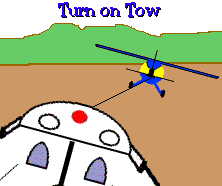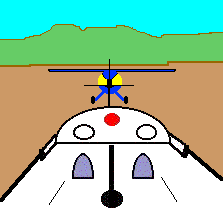Glider Tow Positions
The high-tow is normally used for glider tow operations. However, a low-tow position may be used in some instances, a cross-country tow for example. The main goal of both positions is to place the glider in a position that avoids the wake of the tow plane.


Turns on Tow
All turns are performed in a gentle and gradual manner. The pilot of the glider will attempt to fly the exact flight path of the tow plane. To do this the pilot will point the nose of the glider at the outside wing tip of the tow plane during a turn.

Turns may be initiated upon reaching a safe altitude. Consideration should be given to obstruction clearance, terrain, and wind gradient. Turbulence and differential wing speed of the glider during turns are potential sources of problems.
Due to the length of the wingspan, the roll rate of a glider is typically slower than that of the tow plane. Consequently, the tow pilot should plan all turns with the understanding that the angle of bank determines the turn radius. Since the bank angles of the tow plane and glider must match to fly the same path, normally a maximum of 15-20 degrees of bank is used.
Approaching a Thermal
When approaching a thermal, be vigilant of other gliders. Since the first glider in the thermal establishes the direction of turn, any glider joining the thermal will be required to circle in the same direction as the first glider. This will require the tow pilot to position the flight in a manner that allows the glider proper and safe entry to the thermal. Be super alert when approaching thermals with circling gliders. Expect other gliders to be inbound to the thermal from all directions. Give the thermal traffic a wide berth. If the thermal appears to be especially crowded, steer clear of the activity.
Release
Standard glider release procedures are as follows:
- The pilot of the Glider should ensure the tow line is relatively tight, with no excessive slack, prior to release. This will allow the tow pilot to feel the release of the glider. If the tow rope is visible in the mirror, look for the wrinkle in the tow rope after the glider has released.
- Once it has been confirmed that the glider has released and is clear, the tow pilot should clear the airspace to the left and start a medium bank, descending left turn.
- The Glider should turn right after release, but may proceed straight ahead a few moments before turning right. Be alert for non-standard maneuvering by the glider.

When the tow pilot has positively observed and confirmed the release of the tow line (assumption of release is not acceptable) the pilot of the tow plane may begin a left turn and initiate the descent. In some instances the glider will release with slack in the tow line. This soft release may not be detectable by the tow pilot. If there is any doubt of the release status in the mind of the tow pilot, the tow pilot should continue the tow and confirm the release via radio or visually.


